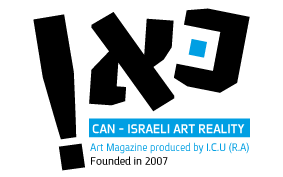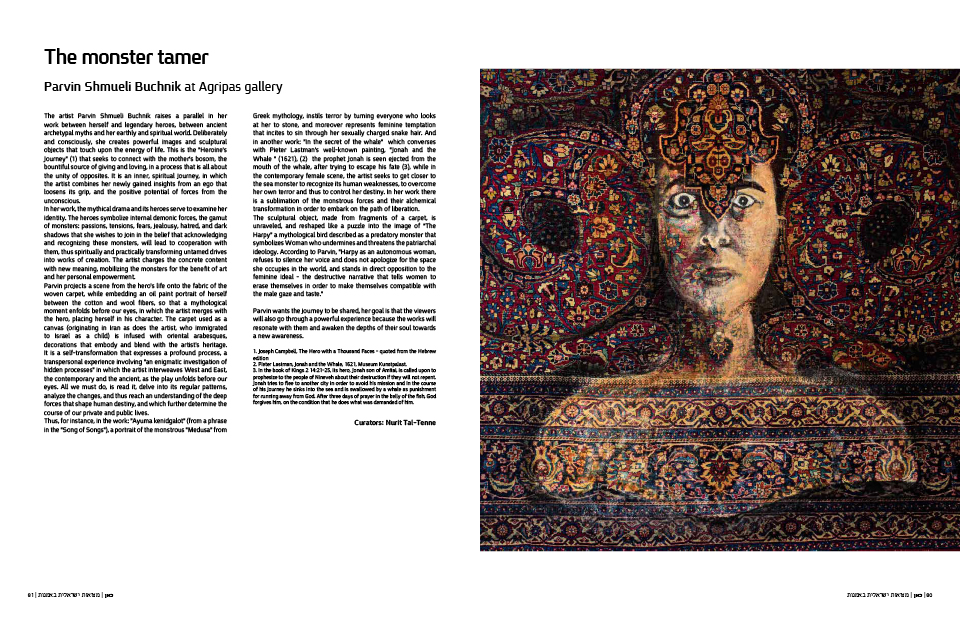
| Home Page | Editor Notices | Museums | Galleries | Publication | Donation | Contact Us |


 | |||||||||||||||
| |||||||||||||||


| |||||||||||||||
| Parvin Shmueli Buchnik at Agripas gallery |
The artist Parvin Shmueli Buchnik raises a parallel in her work between herself and legendary heroes, between ancient archetypal myths and her earthly and spiritual world. Deliberately and consciously, she creates powerful images and sculptural objects that touch upon the energy of life. This is the "Heroine’s Journey" (1) that seeks to connect with the mother’s bosom, the bountiful source of giving and loving, in a process that is all about the unity of opposites. It is an inner, spiritual journey, in which the artist combines her newly gained insights from an ego that loosens its grip, and the positive potential of forces from the unconscious. In her work, the mythical drama and its heroes serve to examine her identity. The heroes symbolize internal demonic forces, the gamut of monsters: passions, tensions, fears, jealousy, hatred, and dark shadows that she wishes to join in the belief that acknowledging and recognizing these monsters, will lead to cooperation with them, thus spiritually and practically transforming untamed drives into works of creation. The artist charges the concrete content with new meaning, mobilizing the monsters for the benefit of art and her personal empowerment. Parvin projects a scene from the hero's life onto the fabric of the woven carpet, while embedding an oil paint portrait of herself between the cotton and wool fibers, so that a mythological moment enfolds before our eyes, in which the artist merges with the hero, placing herself in his character. The carpet used as a canvas (originating in Iran as does the artist, who immigrated to Israel as a child) is infused with oriental arabesques, decorations that embody and blend with the artist’s heritage. It is a self-transformation that expresses a profound process, a transpersonal experience involving "an enigmatic investigation of hidden processes" in which the artist interweaves West and East, the contemporary and the ancient, as the play unfolds before our eyes. All we must do, is read it, delve into its regular patterns, analyze the changes, and thus reach an understanding of the deep forces that shape human destiny, and which further determine the course of our private and public lives. Thus, for instance, in the work: "Ayuma kenidgalot" (from a phrase in the "Song of Songs"), a portrait of the monstrous "Medusa" from Greek mythology, instils terror by turning everyone who looks at her to stone, and moreover represents feminine temptation that incites to sin through her sexually charged snake hair. And in another work: "In the secret of the whale" which converses with Pieter Lastman’s well-known painting, "Jonah and the Whale " (1621), (2) the prophet Jonah is seen ejected from the mouth of the whale, after trying to escape his fate (3), while in the contemporary female scene, the artist seeks to get closer to the sea monster to recognize its human weaknesses, to overcome her own terror and thus to control her destiny. In her work there is a sublimation of the monstrous forces and their alchemical transformation in order to embark on the path of liberation. The sculptural object, made from fragments of a carpet, is unraveled, and reshaped like a puzzle into the image of “The Harpy” a mythological bird described as a predatory monster that symbolizes Woman who undermines and threatens the patriarchal ideology. According to Parvin, "Harpy as an autonomous woman, refuses to silence her voice and does not apologize for the space she occupies in the world, and stands in direct opposition to the feminine ideal - the destructive narrative that tells women to erase themselves in order to make themselves compatible with the male gaze and taste." Parvin wants the journey to be shared, her goal is that the viewers will also go through a powerful experience because the works will resonate with them and awaken the depths of their soul towards a new awareness. 1. Joseph Campbell, The Hero with a Thousand Faces – quoted from the Hebrew edition 2. Pieter Lastman, Jonah and the Whale, 1621, Museum Kunstpalast. 3. In the book of Kings 2 14:21-25, its hero, Jonah son of Amitai, is called upon to prophesize to the people of Nineveh about their destruction if they will not repent. Jonah tries to flee to another city in order to avoid his mission and in the course of his journey he sinks into the sea and is swallowed by a whale as punishment for running away from God. After three days of prayer in the belly of the fish, God forgives him, on the condition that he does what was demanded of him. Curators: Nurit Tal-Tenne Read more  |
| all rights reserved - CAN ISRAELI ART REALITY |
| סייבורג מחשבים - בניית אתרים |